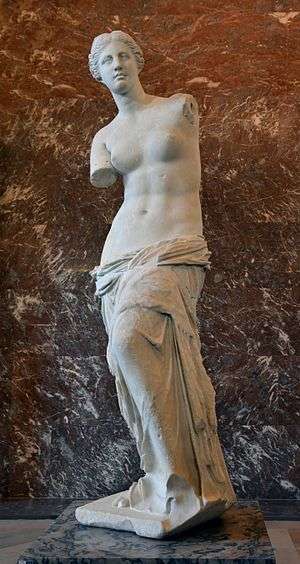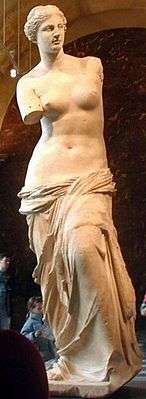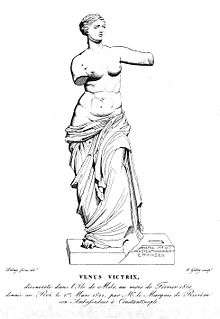Venus de Milo
| Venus de Milo | |
|---|---|
 | |
| Artist | Alexandros of Antioch |
| Year | Between 130 and 100 BC |
| Type | Marble |
| Dimensions | 203 cm (80 in) |
| Location | Louvre Museum, Paris, France |
| Part of a series on | ||||||
| Ancient Greek religion | ||||||
|---|---|---|---|---|---|---|
 | ||||||
|
Godheads
|
||||||
|
Ethics |
||||||
|
Practices |
||||||
|
| ||||||





Aphrodite of Milos (Greek: Αφροδίτη της Μήλου, Aphroditi tis Milou), better known as the Venus de Milo, is an ancient Greek statue and one of the most famous works of ancient Greek sculpture. Created sometime between 130 and 100 BC, the statue is believed to depict Aphrodite, the Greek goddess of love and beauty (Venus to the Romans). It is a marble sculpture, slightly larger than life size at 203 cm (6 ft 8 in) high. Part of an arm and the original plinth were lost following its discovery. From an inscription that was on its plinth, the statue is thought to be the work of Alexandros of Antioch; earlier, it was mistakenly attributed to the master sculptor Praxiteles. It is currently on permanent display at the Louvre Museum in Paris. The statue is named after the Greek island of Milos, where it was discovered.
Description
The Aphrodite of Milos is widely renowned for the mystery of her missing arms.[1] There is a filled hole below her right breast that originally contained a metal tenon that would have supported the separately carved right arm.
Discovery and history
The Aphrodite of Milos was discovered on 8 April 1820 by a peasant named Yorgos Kentrotas, inside a buried niche within the ancient city ruins of Milos, the current village of Tripiti, on the island of Milos (also Melos, or Milo) in the Aegean, which was then a part of the Ottoman Empire.[2] Elsewhere the discoverers are identified as Yorgos Bottonis and his son Antonio.[3] Carus gave the site of discovery as "the ruins of an ancient theater in the vicinity of Castro, the capital of the island", adding that Bottonis and his son "came accidentally across a small underground cave, carefully covered with a heavy slab and concealed, which contained a fine marble statue in two pieces, together with several other marble fragments. This happened in February, 1820". He apparently based these assertions on an article he had come across in the Century Magazine, 1881, Vol. I, p. 99. Notwithstanding these anomalies the consensus is that the statue was found in two large pieces (the upper torso and the lower draped legs) along with several herms (pillars topped with heads), fragments of the upper left arm and left hand holding an apple, and an inscribed plinth. Olivier Voutier, a French naval officer, was exploring the island. With the help of the young farmer, Voutier began to dig around what were clearly ancient ruins. Within a few hours Voutier had uncovered Venus de Milo. About ten days later, another French naval officer, Jules Dumont d'Urville, recognized its significance and arranged for a purchase by the French ambassador to Turkey, Charles-François de Riffardeau, marquis, later duc de Rivière.
Twelve days out of Toulon the ship was anchored off the island of Melos. Ashore, d'Urville and [fellow officer] Matterer met a Greek farmer named Moraitis, who a few days earlier while ploughing his fields had uncovered blocks of marble and a statue in two pieces, which he offered cheaply to the two young men. The marble base where the Venus de Milo originally stood still resides today on the property of his great, great nephew, Dimitri Moraitis. The Venus de Milo is a statue of a naked woman with an apple in her raised left hand, the right hand holding a draped sash falling from hips to feet, both hands damaged and separated from the body. Even with a broken nose, the face was beautiful. D'Urville the classicist recognized the Venus of the Judgement of Paris. It was, of course, the Venus de Milo. He was eager to acquire it, but his practical captain, apparently uninterested in antiquities, said there was nowhere to store it on the ship, so the transaction lapsed. The tenacious d'Urville on arrival at Constantinople showed the sketches he had made to the French ambassador, the Marquis de Rivière, who sent his secretary in a French Navy vessel to buy it for France. Before he could take delivery, French sailors had to fight Greek brigands for possession. In the mêlée the statue was roughly dragged across rocks to the ship, breaking off both arms, and the sailors refused to go back to search for them.[4]
This story however proved to be a fabrication – Voutier's drawings of the statue when it was first discovered show that its arms were already missing (Curtis, 2003).
News of the discovery took longer than normal to get to the French ambassador. The peasant grew tired of waiting for payment and was pressured into selling it to Nicholas Mourousi, Grand Dragoman of the Fleet, working as a translator for Sultan Mahmud II in Constantinople (present day Istanbul, Turkey). The French ambassador's representative, Hermes de Marcellus, arrived just as the statue was being loaded aboard a ship bound for Constantinople and seized the statue and persuaded the island's chief citizens to annul the sale.
Upon arrival at the Louvre, the statue was reassembled, but the fragments of the left hand and arm were dismissed initially as being a later restoration because of the rougher workmanship. It now is accepted that the left hand holding the apple and the left arm are in fact original to the statue, but were not so well finished as the rest of the statue since they would have been somewhat above visible level and difficult to see. This was a standard practice for many sculptors of the era—less visible parts of statues often were not so well finished since typically, they would be invisible to the casual observer. Sculptures and statues from this era normally were carved out of several blocks of stone and carefully pieced together. The Venus de Milo was found to have been carved from at least six or seven blocks of Parian marble: one block for the nude torso, another for the draped legs, one for each arm, a small block for the right foot, a block for the inscribed plinth, and the separately carved herm that stood beside the statue.
Initially, the plinth was found to fit perfectly as part of the statue, but after its inscription was translated and dated, the embarrassed experts who had publicized the statue as a possible original work by the artist Praxiteles dismissed the plinth as a later addition. The inscription read: "...(Alex)andros son of Menides, citizen of Antioch on the Maeander made this (statue)..." The inscribed plinth would have moved the dating of the statue from the Classical period to the Hellenistic period because of the style of lettering and the mention of the ancient city of Antioch on the Maeander, which did not exist in the early fourth century BC, when Praxiteles lived. At that time, the Hellenistic Age was considered a period of decline for Greek art. The quality of workmanship of the carving would not have fit the incorrect assessment of Hellenistic art. The plinth mysteriously disappeared shortly before the statue was presented to King Louis XVIII in 1821, and evidence of it only survives in two drawings and an early description. The king eventually presented the statue to the Louvre museum in Paris.
In 1871, during the Paris Commune uprising, many public buildings were burned. The Venus de Milo statue was secreted out of the Louvre Museum in an oak crate and hidden in the basement of Prefecture of Police. Though the Prefecture was burned, the statue survived undamaged.[5]
In 1920, sculptor Robert Ingersoll Aitken created a stir when he criticized the display, lighting, and placement of the statue of Venus de Milo in the museum.[6]
In the autumn of 1939, the Venus was packed for removal from the Louvre in anticipation of the outbreak of war. Scenery trucks from the Comédie-Française transported the Louvre's masterpieces to safer locations in the countryside.[7] During World War II, the statue was sheltered safely in the Château de Valençay, along with the Winged Victory of Samothrace and Michelangelo's Slaves.[8]
The great fame of the Venus de Milo during the nineteenth century was not simply the result of its admitted beauty; it also owed much to a major propaganda effort by the French authorities. In 1815, France had returned the Medici Venus to the Italians after it had been looted by Napoleon Bonaparte. The Medici Venus, regarded as one of the finest classical sculptures in existence, caused the French to promote the Venus de Milo as a greater treasure than that which they recently had lost. The statue was praised dutifully by many artists and critics as the epitome of graceful female beauty. However, Pierre-Auguste Renoir was among its detractors, labeling it a "big gendarme".[9]
Modern use
The statue has greatly influenced masters of modern art; one prime example is Salvador Dali's Venus de Milo with Drawers.
The statue was formerly part of the seal of the American Society of Plastic Surgeons (ASPS), one of the oldest associations of plastic surgeons in the world.[10]
In February 2010, the German magazine Focus featured a doctored image of this Venus giving Europe the middle finger, which resulted in a defamation lawsuit against the journalists and the publication.[11] They were found not guilty by the Greek court.[12]
A plot to steal the statue is at the center of the 1966 spoof spy film, The Last of the Secret Agents?, starring Marty Allen and Steve Rossi.
Venus was described in the fifth verse of Chuck Berry's song "Brown Eyed Handsome Man".
See also
References
- ↑ Gregory Davidson, Disarmed: The Story of the Venus de Milo (New York: Alfred A. Knopf) 2003.
- ↑ "Venus de Milo (sculpture)". Britannica.com Inc. Encyclopædia Britannica. Retrieved 6 April 2011.
- ↑ The Venus of Milo. An Archaeological Study of the Goddess of Womanhood by Paul Carus The Open Court Publishing Company Chicago London 1916, available online at archive.org
- ↑ S.-C. Dumont D'Urville Two Voyages to the South Seas, Memoirs of Captain Jules. Introduction by Helen Rosenmann.
- ↑ The Greater Journey, David McCullough, p.326
- ↑ "Criticises museum sculpture settings; Robert Aitken says famous venus de Milo in the Louvre is worst placed of all. Stirs federation of arts academician hits at the Metropolitan among home museums and dwells on poor lighting." (pdf). New York Times. 21 May 1920. Retrieved 30 January 2011.
- ↑ Nicholas 1995, p. 55
- ↑ Nicholas 1995, p. 87
- ↑ Francesca Bonazzoli and Michele Robecchi, Mona Lisa to Marge: How the World's Greatest Artworks Entered Popular Culture (New York: Prestel) 2014.
- ↑ Brent, Burt (June 2008). Journals.lww.com "The Reconstruction of Venus: Following Our Legacy". Plastic & Reconstructive Surgery, Journal of the American Society of Plastic Surgeons. Volume 121, Issue 6, pp 2170-2171
- ↑ "Greece Pursues Venus Defamation Case", Diehn, Sonya Angelica Courthouse News Service. 1 December 2011
- ↑ "Greek Court acquits Focus journalists". Burda Newsroom, 3 April 2012
Notes
- Curtis, Gregory. (2003). Disarmed: The Story of the Venus de Milo. New York: Alfred A. Knopf. ISBN 978-0-375-41523-4; OCLC 51937203
- Nicholas, Lynn H. (May 1995) [1994]. The Rape of Europa: The Fate of Europe's Treasures in the Third Reich and the Second World War. New York City: Vintage Books. ISBN 978-0-679-40069-1. OCLC 32531154.
- Venus de Milo: The Oxford Dictionary of Art
- James Grout, Venus de Milo, part of the Encyclopædia Romana
External links
| Wikimedia Commons has media related to Venus de Milo. |
- Venus de Milo - official page
- 3D model of Venus de Milo via photogrammetric survey of an 1850 Louvre atelier plaster cast at Skulpturhalle Basel museum
- Musée du Louvre – Louvre Museum : Venus de Milo